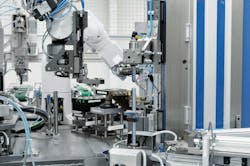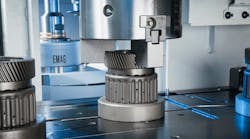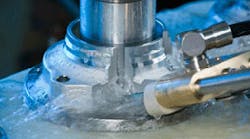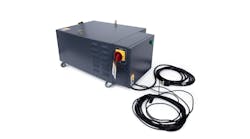The adjustments never end for manufacturers supplying automakers with components and systems – in particular as the OEMs strive to speed up their design processes and implement the changes in their products. For the suppliers, it’s no small thing to adjust to design changes, but they do what is expected, including adopting wholly new production processes.
For example, composite camshafts are a relatively new automotive design, and they continue to gain marketshare (for example, in commercial truck manufacturing) thanks to the considerable weight savings they bring, particularly in comparison to one-piece camshafts. In addition to the weight savings, the composite versions are less expensive, allow the designer to identify and apply different materials for the various constituents, provide greater flexibility in production, and invite designers to implement new cam geometries, such as negative radii. But most important, composite camshafts help to reduce fuel consumption – as well as CO2 emissions.
However, alternative processes for joining cams and shafts have one serious disadvantage: the two component parts cannot be joined with the necessary accuracy to avoid a subsequent finish grinding process. In many cases, joining a cam to a tube is carried out using a form-fit process like press-fitting, knurling, and/or spline/serrated gearing. The joining forces required for these processes can deform the components and result in unacceptable tolerances in cam position and orientation.
Thermal Joining Detailed
In response to this, CNC machine tool designer EMAG LLC developed (and patented) a heat-shrink assembly process that it said produces “ready-to-fit“ camshafts, gear shafts, and other precision composite units without problems.
Thermal joining, i.e. the heat shrinking of cam onto tube, ensures that the required tolerances are achieved with a reaction force-free process. The technique for controlling the process parameters of “temperature” and “time” – and the mechanical design of the joining equipment – is important in this process.
An optimal combination of robot and special-concept gripping technology makes it possible to achieve fusion gaps of < 15 µm with safety. The concept’s flexibility allows product developers more freedom in their designs and ensures that the process can be used for different batch sizes — which is notable in an industrial sector that endures frequent changes in component types.
The high degree of precision of the composite camshaft drastically reduces the need for subsequent grinding of the cams, or does away with the requirement completely when precision cams are used.
A further advantage of this process is the option to use different materials for the composite shaft. This includes forged cams (e.g., 100Cr6), or finish-ground cams, or even dimensionally accurate sintered cams that do not require a finish-grinding step. Secondary components, such as bungs and endpieces, can be made of more advantageous materials, just like the actual shaft.
All this allows the camshaft to be made to suit the requirements of the engine and to optimize it in terms of load bearing capacity and manufacturing costs.
One Further Step
When the camshaft needs to be ground after heat shrink assembly, the joining machine can be linked to a grinder. EMAG simplifies this step with the availability of its VTC DS Series. With this setup, the joining machine robot transfers the assembled camshaft directly to the loading position on the grinding center.
The advantages of this process also apply to machining of other components. When machining gear shafts, ground gears can be joined tightly to the shaft without needing to design for grinding wheel overrun. It also minimizes the length of the shaft and makes the whole unit more compact.
EMAG’s process is characterized by only a few machining components contacting the workpiece. It allows for the machines to be reset in the shortest possible time, typically less than 15 minutes.
The heat-shrink assembly process offered by EMAG combines flexibility with productivity, while freedom of design and choice of production technologies ensure a short cycle time. While one cam is heat shrinking, the next one is already being preheated. Equipping the heat shrinking machine with a number of preheating units allows for the optimal application of this technology to the task at hand. It is these advantages that may well be the reason why so many firmly established manufacturers of camshafts and other precision assemblies are showing such a great interest in the new process, are asking for machining tests, or are already applying the process under actual production conditions. In the ideal case, the customer will take advantage of the synergy provided by the EMAG Group and ask for a complete concept to be prepared that covers everything from pre-machining to heat shrinking and end machining.









